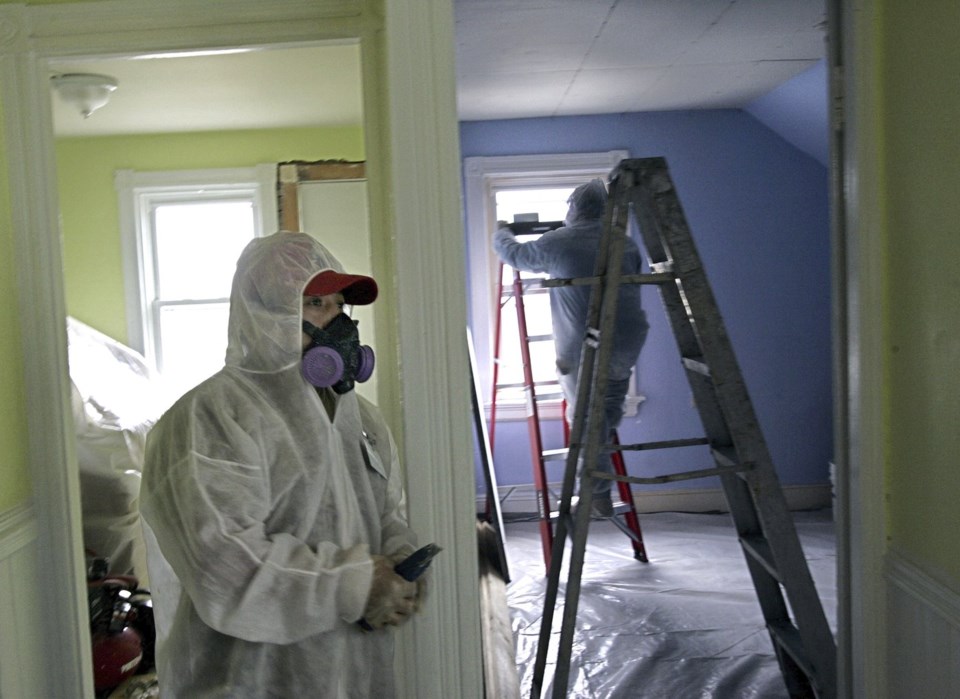WASHINGTON (AP) — Two weeks after setting a , the Biden administration is imposing in older homes and child-care facilities.
A final rule announced Thursday by the Environmental Protection Agency sets limits on lead dust on floors and window sills in pre-1978 residences and child-care facilities to levels so low they cannot be detected.
Paint that contains lead was banned in 1978, but more than , including nearly 4 million homes where children under the age of 6 live. Lead paint can chip off when it deteriorates or is disturbed, especially during home remodeling or renovation.
“The science is clear: There is no safe level of lead,” said Michal Freedhoff, EPA's assistant administrator for chemical safety and pollution prevention. “It is time to finally rid the country of the scourge that lead paint has posed to our children’s health” for generations, she said.
The EPA estimates the new rule will reduce the lead exposures of up to 1.2 million people per year, including 178,000 to 326,000 children under age 6.
Lead is a neurotoxin that can irreversibly harm brain development in children, lower IQ, cause behavioral problems and lead to lifelong health effects. It also affects other organs, including the liver and kidneys.
The new rule, which takes effect early next year, targets levels of lead dust generated by paint. Currently, 10 micrograms per square foot is considered hazardous on floors, and a concentration 10 times that high is considered hazardous on window sills. The new rule brings both of those levels down to no detectable lead.
The proposed rule also would reduce what level is allowed when a lead-abatement contractor finishes work on a property where lead has been identified as a problem. These levels would be 5 micrograms per square foot on the floor and 40 micrograms per square foot for sills.
Individuals and firms that perform abatement work must be certified and follow specific work practices. Testing is required afterward to ensure dust-lead levels are below the new standards.
Environmental justice and public health experts called the EPA rule long overdue, noting that lead poisoning disproportionately affects low-income communities and communities of color.
“We can all breathe a little easier now that the EPA has significantly lowered its dust lead standard to protect children,” said Peggy Shepard, co-founder and executive director of WE ACT for Environmental Justice, a New York-based advocacy group.
Shepard, who serves on the White House Environmental Justice Advisory Council, said New York state leads the nation in cases of children with elevated blood levels. Black children in Harlem living below the poverty line are twice as likely to suffer from lead poisoning as poor white children, she said.
The U.S. government has gradually been reducing the standard for what counts as poisonous levels of lead in children's blood, with the most recent change But the EPA rule, , marks an effort to take more proactive action.
“When you are relying on the blood lead level in children to indicate whether there is lead in the environment, we are basically using the children as canaries in the mine,” said Dr. Philip Landrigan, a Boston College biology professor who directs the school's Program for Global Public Health and the Common Good.
The National Child Care Association said the rule could hurt thousands of child-care centers that are already struggling financially — especially those in low-income neighborhoods, where the facilities tend to be older. Without financial assistance, the new standards could push small child-care centers to close, said Cindy Lehnhoff, the group’s director.
“These necessary upgrades come at a cost,'' she said. “Somebody has to come up with the money to do this.''
Nicole Upano, assistant vice president of the National Apartment Association, said the group shares the administration’s commitment to reducing childhood lead poisoning.
“As written, however, the EPA’s lead dust rule places the sole onus on the nation’s housing providers to remediate dust levels to absolute zero – an impossible task,'' she said in a statement. The association remains concerned that the EPA rule may "ultimately reduce the availability and affordability of rental housing for families with children,'' Upano said.
The White House and EPA officials said federal funding is available, noting that the Department of Housing and Urban Development recently announced $420 million in grants to remove lead hazards from homes, including HUD-assisted homes. Additional HUD grants will continue to be available to help with lead paint removal, the White House said.
Matthew Daly, The Associated Press




